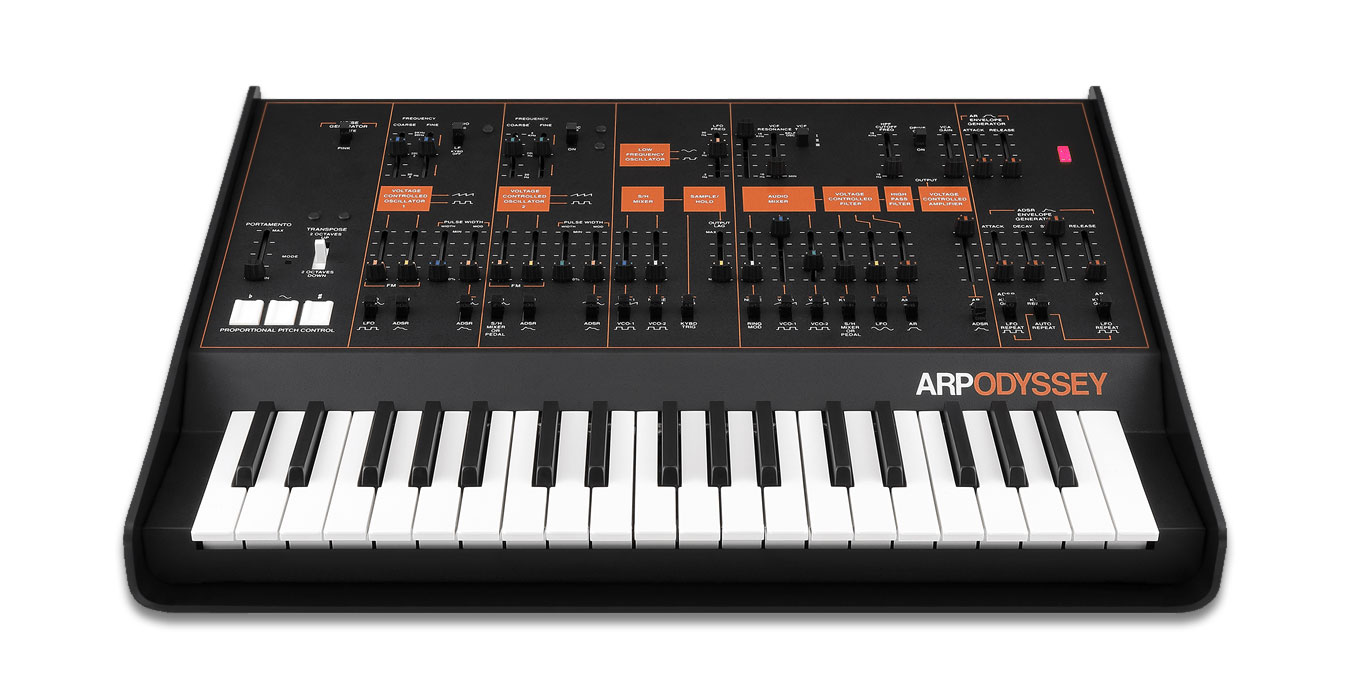ARP ODYSSEY FS - Successor of The Duophonic Legend of Analog Synthesis

Synthesizers are not just instruments – they are gateways into sonic worlds that shape musical history. ARP Odyssey is one of those instruments that left an indelible mark on the development of electronic music. Its duophonic architecture, aggressive analog sound, and compact design made it an iconic synthesizer, finding its place both in studios and on live stages.
History of ARP Odyssey – From Minimoog Competitor to Its Own Legend.
Origins and Development
In 1972, ARP Instruments set out to create a compact analog synthesizer to compete with the popular Moog Minimoog. The result was ARP Odyssey, offering duophonic synthesis, meaning it could play two notes simultaneously – a revolutionary concept at the time.
Odyssey went through three main revisions:
• Rev. 1 (1972–1974) – White panel, 12dB/oct filter similar to Oberheim SEM.
• Rev. 2 (1975–1976) – Black panel with gold trim, 24dB/oct Moog-style filter.
• Rev. 3 (1978–1981) – Black panel with orange markings, new ARP 4075 filter.
Each version had a distinct sound character, making the Odyssey popular among various music genres – from progressive rock to electronic avant-garde.
Reissue by Korg – The Return of a Legend
In 2015, Korg announced the reissue of ARP Odyssey, developed in collaboration with David Friend, co-founder of ARP Instruments. Korg aimed to preserve its authentic analog sound while adding modern enhancements such as MIDI and USB connectivity.
In 2020, Korg introduced the ARP Odyssey FS, a full-sized version featuring a standard keyboard, bringing back the exact playing experience of the original Odyssey.
Technical Structure – The Building Blocks of ARP Odyssey FS Sound
Duophonic Oscillators – The Power of Two Voices
ARP Odyssey FS features two oscillators that allow duophonic synthesis – playing two notes simultaneously.
• Oscillator 1 – Offers sawtooth, square, and pulse wave with PWM modulation.
• Oscillator 2 – Has identical waveforms but can be synchronized with Oscillator 1 for aggressive
sounds.
• Ring Modulator – Enables the combination of both oscillators, creating metallic and experimental
tones.
Three Filter Types – Manual Switching for Authentic Sound
One of the most unique features of ARP Odyssey FS is the ability to manually switch between three filter types, corresponding to historical Odyssey revisions.
• Rev. 1 – 4023 (12dB/oct) – Sharp, aggressive sound similar to Oberheim SEM.
• Rev. 2 – 4035 (24dB/oct) – Moog-style filter with deep bass and warm analog character.
• Rev. 3 – 4075 (24dB/oct) – ARP’s own filter with strong midrange emphasis.
This flexibility allows musicians to select precisely the sound that fits their style.
Modulation and Effects
• Sample & Hold – Generates random modulations, ideal for experimental sounds.
• High-pass Filter – Removes low frequencies for a cleaner mix.
• PPC (Proportional Pitch Control) – Sensitive tuning adjustment via touch sensors.
Expansion and Modifications
ARP Odyssey FS is already a powerful analog synthesizer, but many users seek ways to modify and expand its capabilities. Common modifications include adding extra CV outputs, adjusting envelope generator parameters, and integrating an external sequencer.
One of the most frequent requests is extending CV/Gate connectivity, allowing better integration with modular synthesizers and external controllers. Some technicians develop modification kits that add CV output for each oscillator, expanding modulation possibilities within complex setups.
Another modification involves envelope generators, where users sometimes prefer slower attack phases or extended sustain. Adjusting circuit values can alter the envelope’s behavior to be more responsive to performance nuances.
For musicians working with sequencers, adding an external step sequencer is particularly useful, enabling more precise control over pitch variations and rhythmic patterns. Some modification kits offer inputs for analog step sequencers, further enhancing the creative potential of ARP Odyssey FS.
Besides electronic modifications, users often personalize the synthesizer’s aesthetic, changing panel colors or replacing knobs with custom designs for better tactile control.
These modification options show that ARP Odyssey FS remains a flexible instrument, adaptable to different users’ needs – from studio producers to live performers.
Alternative Versions – ARP Odyssey Module & ARP Odyssey FS Kit
ARP Odyssey Module – Desktop Variant
In addition to the full keyboard version, the Odyssey FS was also produced as a desktop version, known as the ARP Odyssey Module.
• Same analog circuit as Odyssey FS.
• Compact design without a keyboard.
• Compatible with MIDI controllers and sequencers.
This version was perfect for producers who wanted the analog Odyssey sound but did not need a built-in keyboard.
ARP Odyssey FS Kit – Build Your Own Synthesizer
In 2023, Korg introduced the ARP Odyssey FS Kit, a DIY version allowing musicians to assemble their own ARP Odyssey FS.
• All components provided separately.
• No soldering required – simple assembly. Each unit features a unique serial number.
This edition was ideal for synth enthusiasts who wanted to experience the process of assembling their own analog instrument.
Cultural Impact of ARP Odyssey
Legendary Songs Featuring ARP Odyssey:
• Herbie Hancock – Chameleon.
• Gary Numan – Cars.
• Jean-Michel Jarre – Oxygene.
• Depeche Mode – Stripped.
Artists Who Used ARP Odyssey:
• Herbie Hancock – jazz fusion innovator.
• Gary Numan – synth-pop pioneer.
• Jean-Michel Jarre – electronic avant-garde.
• Trent Reznor (Nine Inch Nails) – industrial experimenter.
• Orbital – British electronic music.
• etc.
Conclusion
ARP Odyssey FS remains a timeless synthesizer, preserving its authentic analog sound while adapting to the modern needs of musicians.
Thanks to the Korg reissue, the desktop version Odyssey Module, and the DIY Odyssey FS Kit, this instrument has become accessible to a new generation of musicians. Its duophonic synthesis, flexible filters, and iconic sound make it a true legend of analog synthesis.
| |
|
|
|
|
|
|
|
|


